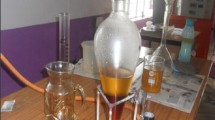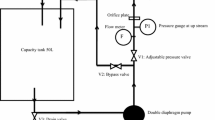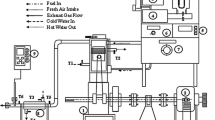Abstract
In this study, bioethanol produced from sugar beet and biodiesel produced from waste cooking oils was blended with each other in the volumetric rates to be 20% and 80%, respectively. Cetane improver (di-tert-butyl peroxide) was added into blend fuel in 1–2–3% as volumetric. The obtained blends were used as a fuel in the diesel engine which is single-cylinder, direct-inject, four-stroke. The tests were conducted under four different engine loads (25%, 50%, 75% and 100%) and 1400 rpm engine speed. The test results showed that brake-specific fuel consumption was decreased up to 15.5% thanks to the addition of cetane improver, although biodiesel and bioethanol increased brake-specific fuel consumption by 16.1% and 27.54%, respectively. However, brake thermal efficiency values were increased up to 9.44% with both biodiesel and cetane improver added blend fuels, while brake thermal efficiency was decreased by 3.88% with bioethanol addition. The more compatible combustion characteristics with that of diesel fuel have been obtained due to especially the increase in cetane number. The use of biofuels increased both maximum cylinder pressure and heat release rate. While, with the cetane improver addition, a decrease in CO, HC and smoke opacity values was observed up to 22.5%, 17.44% and 24.44%, respectively, CO2, NOX and exhaust gas temperature values were increased up to 19.55%, 5% and 15.22%, respectively, according to bioethanol blend fuel.











Similar content being viewed by others
Abbreviations
- BSFC:
-
Brake-specific fuel consumption
- BTE:
-
Brake thermal efficiency
- CA:
-
Crank angle
- CA50:
-
Crank angle point for 50% accumulated HRR
- CA90:
-
Crank angle point for 90% accumulated HRR
- CBD:
-
Cotton biodiesel
- cDF:
-
Conventional diesel fuel
- CI:
-
Cetane index
- CNI:
-
Cetane improver
- CO:
-
Carbon monoxide
- CO2 :
-
Carbon dioxide
- DI:
-
Direct injection
- DTBP:
-
Di-tert-butyl peroxide
- EGT:
-
Exhaust gas temperature
- HC:
-
Hydrocarbon
- HRR:
-
Heat release rate
- HRRmax :
-
Maximum heat release rate
- ID:
-
Ignition delay
- LHV:
-
Lower heating value
- NOx :
-
Nitrogen oxides
- PM:
-
Particular matter
- Pmax :
-
Maximum cylinder pressure
- SoC:
-
Start of combustion
- SoI:
-
Start of ignition
- WB:
-
Waste cooking oil biodiesel
- WBE:
-
80% WB + 20% bioethanol
- WBE1:
-
99% WBE + 1% DTBP
- WBE2:
-
98% WBE + 2% DTBP
- WBE3:
-
97% WBE + 3% DTBP
- WCO:
-
Waste cooking oil
- θHRRmax :
-
Angle of max. heat release rate
- θP max :
-
Angle of max. cylinder pressure
References
Pradelle F, Braga SL, de Aguiar Martins ARF et al (2017) Stabilization of diesel–biodiesel–ethanol (DBE) blends: formulation of an additive from renewable sources. J Braz Soc Mech Sci Eng 39(9):3277–3293
Uyaroğlu A, Uyumaz A, Çelikten İ (2018) Comparison of the combustion, performance, and emission characteristics of inedible Crambe abyssinica biodiesel and edible hazelnut, corn, soybean, sunflower, and canola biodiesels. Environ Prog Sustain Energy 37(4):1438–1447
Rastogi RP, Pandey A, Larroche C et al (2018) Algal Green Energy–R&D and technological perspectives for biodiesel production. Renew Sustain Energy Rev 82:2946–2969
Yarrapragada KR, Krishna BB (2017) Impact of tamanu oil-diesel blend on combustion, performance and emissions of diesel engine and its prediction methodology. J Braz Soc Mech Sci Eng 39(5):1797–1811
Abubakar H, Abdulkareem A, Jimoh A et al (2016) Optimization of biodiesel production from waste cooking oil. Energy Sources Part A: Recovery Util Environ Effects 38(16):2355–2361
Muralidharan K, Vasudevan D (2015) Applications of artificial neural networks in prediction of performance, emission and combustion characteristics of variable compression ratio engine fuelled with waste cooking oil biodiesel. J Braz Soc Mech Sci Eng 37(3):915–928
Mohammed AR, Bandari C (2017) Lab-scale catalytic production of biodiesel from waste cooking oil—a review. Biofuels, 1–11
Wei L, Cheung C, Ning Z (2017) Influence of waste cooking oil biodiesel on combustion, unregulated gaseous emissions and particulate emissions of a direct-injection diesel engine. Energy 127:175–185
Prabu SS, Asokan M, Roy R et al (2017) Performance, combustion and emission characteristics of diesel engine fuelled with waste cooking oil bio-diesel/diesel blends with additives. Energy 122:638–648
Patel C, Chandra K, Hwang J et al (2019) Comparative compression ignition engine performance, combustion, and emission characteristics, and trace metals in particulates from Waste cooking oil, Jatropha and Karanja oil derived biodiesels. Fuel 236:1366–1376
Geng P, Mao H, Zhang Y et al (2017) Combustion characteristics and NOx emissions of a waste cooking oil biodiesel blend in a marine auxiliary diesel engine. Appl Therm Eng 115:947–954
Özgün AK, Eryılmaz T (2018) A comparative study of engine performance and exhaust emissions of biodiesel and its blends produced from waste cooking oil and neutralized waste cooking oil. Int J Automot Eng Technol 7(3):88–97
Kuszewski H (2018) Effect of adding 2-ethylhexyl nitrate cetane improver on the autoignition properties of ethanol–diesel fuel blend–Investigation at various ambient gas temperatures. Fuel 224:57–67
Júnior LCSS, Ferreira VP, da Silva JA et al (2018) Oxidized biodiesel as a cetane improver for diesel–biodiesel–ethanol mixtures in a vehicle engine. J Braz Soc Mech Sci Eng 40(2):79
Wei L, Cheung C, Ning Z (2018) Effects of biodiesel-ethanol and biodiesel-butanol blends on the combustion, performance and emissions of a diesel engine. Energy 155:957–970
Kumar MS, Arul K, Sasikumar N (2019) Impact of oxygen enrichment on the engine’s performance, emission and combustion behavior of a biofuel based reactivity controlled compression ignition engine. J Energy Inst 92:51–61
Candan F, Ciniviz M, Ors I (2017) Effect of cetane improver addition into diesel fuel methanol mixtures on performance and emissions at different injection pressures. Thermal Sci 21(1B):555–566
Karthickeyan V (2019) Data set for effect of cetane enhancer on ceramic coated diesel engine fuelled with neat Moringa oleifera methyl ester. Data Brief 24:103932
Kumar H, Sarma AK, Kumar P (2019) A novel approach to study the effect of cetane improver on performance, combustion and emission characteristics of a CI engine fuelled with E20 (diesel–bioethanol) blend. Sustain Chem Pharm 14:100185
Li R, Wang Z, Ni P et al (2014) Effects of cetane number improvers on the performance of diesel engine fuelled with methanol/biodiesel blend. Fuel 128:180–187
Sun W, Lailliau M, Serinyel Z et al (2019) Insights into the oxidation kinetics of a cetane improver–1, 2-dimethoxyethane (1, 2-DME) with experimental and modeling methods. Proc Combust Inst 37(1):555–564
Venkateswarlu K, Murthy B, Subbarao V (2016) An experimental investigation to study the effect of fuel additives and exhaust gas recirculation on combustion and emissions of diesel–biodiesel blends. J Braz Soc Mech Sci Eng 38(3):735–744
Can Ö (2014) Combustion characteristics, performance and exhaust emissions of a diesel engine fueled with a waste cooking oil biodiesel mixture. Energy Convers Manag 87:676–686
Alptekin E, Sanli H, Canakci M (2019) Combustion and performance evaluation of a common rail DI diesel engine fueled with ethyl and methyl esters. Appl Therm Eng 149:180–191
Labeckas G, Slavinskas S, Kanapkienė I (2017) The individual effects of cetane number, oxygen content or fuel properties on the ignition delay, combustion characteristics, and cyclic variation of a turbocharged CRDI diesel engine–Part 1. Energy Convers Manag 148:1003–1027
Xing-cai L, Jian-Guang Y, Wu-Gao Z et al (2004) Effect of cetane number improver on heat release rate and emissions of high speed diesel engine fueled with ethanol–diesel blend fuel. Fuel 83(14–15):2013–2020
Gattamaneni RNL, Subramani S, Santhanam S et al (2008) Combustion and emission characteristics of diesel engine fuelled with rice bran oil methyl ester and its diesel blends. Thermal Sci 12(1):139–150
Ming C, Fattah IR, Chan QN et al (2018) Combustion characterization of waste cooking oil and canola oil based biodiesels under simulated engine conditions. Fuel 224:167–177
Selvam DJP, Vadivel K (2014) The effects of ethanol addition with waste pork lard methyl ester on performance, emission, and combustion characteristics of a diesel engine. Thermal Sci 18(1):217–228
Alptekin E, Canakci M, Ozsezen AN et al (2015) Using waste animal fat based biodiesels–bioethanol–diesel fuel blends in a DI diesel engine. Fuel 157:245–254
Jamrozik A, Tutak W, Pyrc M et al (2017) Effect of diesel/biodiesel/ethanol blend on combustion, performance and emissions characteristics on a direct injection diesel engine. Thermal Sci 21(1B):591–604
Attia AM, Hassaneen AE (2016) Influence of diesel fuel blended with biodiesel produced from waste cooking oil on diesel engine performance. Fuel 167:316–328
Prbakaran B, Viswanathan D (2018) Experimental investigation of effects of addition of ethanol to bio-diesel on performance, combustion and emission characteristics in CI engine. Alexandria Eng J 57(1):383–389
Hulwan DB, Joshi SV (2011) Performance, emission and combustion characteristic of a multicylinder DI diesel engine running on diesel–ethanol–biodiesel blends of high ethanol content. Appl Energy 88(12):5042–5055
Taymaz I, Coban M (2013) Performance and emissions of an engine fuelled with a biodiesel fuel produced from animal fats. Thermal Sci 17(1):233–240
Yarrapathruni RHV, Voleti SR, Pereddy RN et al (2009) Jatropha oil methyl ester and its blends used as an alternative fuel in diesel engine. Thermal Sci 13(3):207–217
Kaliveer V, Shetty S, Shetty S et al (2017) Effect of biodiesel-ethanol fuel on the performance and emission characteristics of a CI engine. Energy Power 7(4):119–122
Emiroğlu AO, Şen M (2018) Combustion, performance and exhaust emission characterizations of a diesel engine operating with a ternary blend (alcohol-biodiesel-diesel fuel). Appl Therm Eng 133:371–380
Kumar KS, Raj RTK (2016) Effect of di-tertiary butyl peroxide on the performance, combustion and emission characteristics of ethanol blended cotton seed methyl ester fuelled automotive diesel engine. Energy Convers Manag 127:1–10
Abed K, El Morsi A, Sayed M et al (2018) Effect of waste cooking-oil biodiesel on performance and exhaust emissions of a diesel engine. Egypt J Pet 27:985–989
Pilusa T, Mollagee M, Muzenda E (2012) Reduction of vehicle exhaust emissions from diesel engines using the whale concept filter
Ranjan A, Dawn S, Jayaprabakar J et al (2018) Experimental investigation on effect of MgO nanoparticles on cold flow properties, performance, emission and combustion characteristics of waste cooking oil biodiesel. Fuel 220:780–791
Pan M, Huang R, Liao J et al (2018) Effect of EGR dilution on combustion, performance and emission characteristics of a diesel engine fueled with n-pentanol and 2-ethylhexyl nitrate additive. Energy Convers Manag 176:246–255
Yilmaz N, Atmanli A, Trujillo M (2017) Influence of 1-pentanol additive on the performance of a diesel engine fueled with waste oil methyl ester and diesel fuel. Fuel 207:461–469
Atmanli A (2016) Comparative analyses of diesel–waste oil biodiesel and propanol, n-butanol or 1-pentanol blends in a diesel engine. Fuel 176:209–215
Ajav E, Singh B, Bhattacharya T (1999) Experimental study of some performance parameters of a constant speed stationary diesel engine using ethanol–diesel blends as fuel. Biomass Bioenergy 17(4):357–365
Shen X, Shi J, Cao X et al (2018) Real-world exhaust emissions and fuel consumption for diesel vehicles fueled by waste cooking oil biodiesel blends. Atmos Environ 191:249–257
Valente OS, Pasa VMD, Belchior CRP et al (2012) Exhaust emissions from a diesel power generator fuelled by waste cooking oil biodiesel. Sci Total Environ 431:57–61
Ickes AM, Bohac SV, Assanis DN (2009) Effect of 2-ethylhexyl nitrate cetane improver on NO x emissions from premixed low-temperature diesel combustion. Energy Fuels 23(10):4943–4948
Zhang Q, Yao M, Luo J et al (2013) Diesel engine combustion and emissions of 2, 5-dimethylfuran-diesel blends with 2-ethylhexyl nitrate addition. Fuel 111:887–891
Author information
Authors and Affiliations
Corresponding author
Ethics declarations
Conflict of interest
The author declares that he has no conflict of interest.
Additional information
Technical Editor: Mario Eduardo Santos Martins, Ph.D..
Publisher's Note
Springer Nature remains neutral with regard to jurisdictional claims in published maps and institutional affiliations.
Rights and permissions
About this article
Cite this article
Örs, İ. Experimental investigation of the cetane improver and bioethanol addition for the use of waste cooking oil biodiesel as an alternative fuel in diesel engines. J Braz. Soc. Mech. Sci. Eng. 42, 177 (2020). https://doi.org/10.1007/s40430-020-2270-1
Received:
Accepted:
Published:
DOI: https://doi.org/10.1007/s40430-020-2270-1




